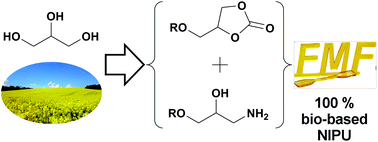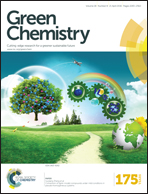Multifunctional β-amino alcohols as bio-based amine curing agents for the isocyanate- and phosgene-free synthesis of 100% bio-based polyhydroxyurethane thermosets†
Abstract
The aminolysis of bio-based glycidylethers and limonene dioxide with aqueous ammonia represents a versatile one-step synthesis of multifunctional bio-based amine curing agents and does not require either organic solvents besides bioethanol or tedious purification. Moreover, the identical bio-based glycidylether serves as the raw material for both the amine curing agent and the polyfunctional cyclic carbonate, both of which are key intermediates in non-isocyanate polyhydroxyurethane (NIPU) production. This study elucidates the influences of molecular architecture and amine content of multifunctional β-amino alcohol (AA) curing agents, as determined by means of 13C-NMR spectroscopy, and the type of polyfunctional cyclic carbonates on the thermal and mechanical NIPU properties, NIPU degradation and NIPU solvent swelling. Preferably, owing to their rather high viscosities, polyfunctional AAs are blended together with hexamethylene diamine (HMDA) to enable facile NIPU cure at ambient temperatures. As compared to HMDA, the addition of the less reactive polyfunctional AAs increases gel time, as measured by oscillatory rheological experiments, and simultaneously improves NIPU stiffness, as determined by Young's modulus (+200%).


 Please wait while we load your content...
Please wait while we load your content...